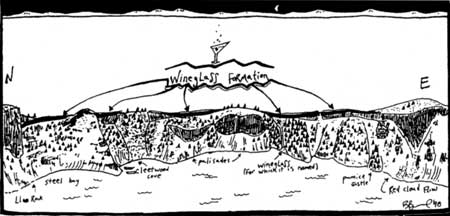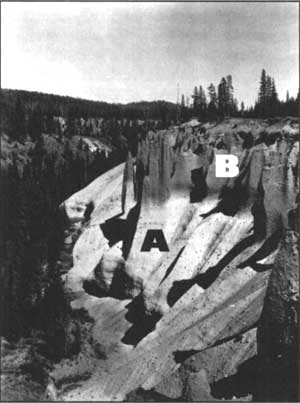Now, in Figure 2c, if you were to do the same thing that you did in 2b. the types of ash and lava that you would find after the Crater Lake climactic eruption would only be from the basaltic-andesite (#2) and the rhyodacite (#5) groups. Let’s plot them on the same kind of graph that we did before. The dots would only be in those two regions. When the products of an eruption are limited to two distinct, clumped groups, the system that fed this rare eruption is said to be bi-modal. This is one of the aspects of the climactic eruption that makes Crater Lake so unique.
As the eruption continued, the cloud grew so large and heavy that the released gases could not hold it all up and some parts fell back down on the volcano. These super hot flows of ash and rock (called pyroclastic flows) rushed down the flanks of Mount Mazama, and deposited pumice with such heat and pressure that the pumice was compressed and welded. A deposit of welded pumice brought about the Wineglass Formation. This is the long orange colored deposit of ash and pumice that stretches from Llao Rock to Red Cloud on the north and east side of the inner caldera wall. It is illustrated in figure 3.
Figure 3. The Wineglass Formation (indicated by a thick black line) stretches from Llao Rock on the north side of the caldera wall to Red Cloud flow on the east side. It resulted from a pyroclastic flow in the first phase of the climactic eruption. The formation is best seen by hiking about 1/8 mile down the Cleetwood Trail, where a huge orange-colored ash flow tuff is evident. Tuff is a name given to ash when it is deposited so hot that it partially melts and recrystallizes, forming a hardened mass. Look closely at the tuff and you should see narrow lens-shaped pieces which are squished pumice from the hot flow.
Both the airfall ash and pumice and the pyroclastic flows forming the Wineglass were from the single vent phase. The single vent phase of the climactic eruption drained a large portion of the magma chamber, which left the volcano without a sturdy foundation. As it began to collapse inward, the force of the volcano was so great that it pushed the remaining contents in the magma chamber out along the fractures and cracks that the volcano produced as it broke inward. This activity sent out even larger pyroclastic flows than did the first phase. These rushed past the flanks and out into the once glaciated valleys and deposited rhyodacite and andesite. It is significant that all of the deposits from the first phase are high silica rhyodacite, while the pyroclastic deposits from the second (or ring vent) phase of that eruption began with rhyodacite but ended with basaltic-andesite. There were no intermediate or transitional compositions during the two phases of this eruption.
It is highly improbable that a magma chamber would show two very different types of chemistries unless the compositions were separated from each other into layers within the magma chamber. Layered magma chambers are not uncommon and, in fact, they are thought to be quite ordinary. Most of the time, however, these chambers exhibit a spectrum of layered compositions–not just two main ones like Mount Mazama, How one of these layered magma chambers forms requires some knowledge of the magmas themselves. Rhyolites, rhyodacites, and dacites are considered to be high in silica, explosive, and extremely viscous–hence the categorization “silicic”. Basalts, basaltic-andesites, and andesites are considered to be lower in silica, less viscous, erupted at higher temperatures (less than 1200 degrees Centigrade), more dense than the silicic types, and are classified as “mafic” magma. If we could, hypothetically, pour these two opposite types into a big bowl, the less dense silicic type would rise above the more dense mafic type. The same thing, in essence, happens in a magma chamber where the less dense silica-rich magma rides upon the mafic type in the general shape of a lens.
A layered, lens-shaped magma chamber is believed to have existed beneath Mazama when it catastrophically erupted about 7,700 years ago. The most impressive surface manifestation of the chamber can be seen at the Pinnacles, which are found in the once glaciated valleys of Wheeler and Sand Creeks just south of Lost Creek Campground. During the second phase of the climactic eruption, pyroclastic flows rushed down these valleys and filled them. These violent flows may have rushed for miles with speeds over 100 mph and then suddenly terminated. In stopping so abruptly, the flows trapped large amounts of hot gases at the lower levels. As these gases rose toward the surface, they heated the ash and pumice so that they partially melted and recrystallized. This recrystallization process changed the soft ash into a hardened material. The hardened ash and pumice formed around the path of the escaping gas and began to act as a chimney. Over time, streams flowed through these pumice and ash filled valleys. This left the resistant pinnacles standing and eroded the softer, unaltered ash. When you look at these pinnacles, you are actually seeing the subsurface structure that escaping volcanic gases created.
By observing closely, you will see that the upper regions of the pinnacles are darker mafic material, and the lower regions are lighter silicic material. Notice how sharp the contact is between the two (shown in figure 4). Remember how the upper silicic magma rests upon the denser mafic magma in the magma chamber. When erupted, this material would be in reversed sequence (just like if we were to erupt an “n”, it would land as a “u”). That sharp contact shows just how unmixed these compositions actually were, as if they were separated from each other in the chamber by a giant wall that disallowed any mixing to occur. The single vent phase had already removed a large portion of the chamber’s upper level, which was high silica rhyodacite. When the volcano began to collapse in on itself and erupt in the ring vent phase, the remaining rhyodacite was pushed out, as well as the underlying basaltic-andesite zone (you may wish to consult Figure 1 again to see the general structure of the magma chamber). When both of these layers erupted, the clouds of gas and ash were violently deposited in these valleys with the rhyodacite on the bottom, and the basaltic-andesite above it.
As stated previously, the intermingling of silicic and mafic magma is the most important piece of evidence that the chamber feeding the mountain during the climactic eruption was layered with a lens of mostly gaseous, silicic magmas separated from the dense basaltic material beneath it. This evidence is only representative of the climactic eruption, and it is worth asking whether the chamber was becoming bimodal before that time. If so, when? Fortunately the rocks at Williams Crater can help to answer that question.
Williams Crater, once known as Forgotten Crater, is named after Howel Williams who wrote the Geology of Crater Lake National Park. Published in 1942, the work is considered a classic–even though Williams did not have the benefit of modern dating techniques. His interpretation of the park’s geology has been modified only slightly in the past half century by Charles Bacon of the U.S. Geological Survey. It is therefore fitting that this namesake feature represents a very crucial and critical aspect in understanding the volcanic system which created Crater Lake.



